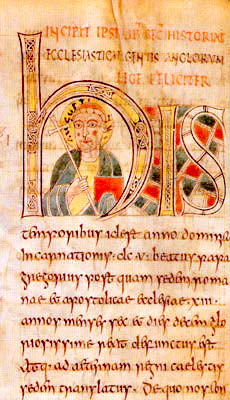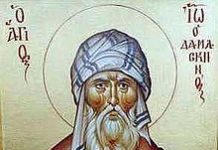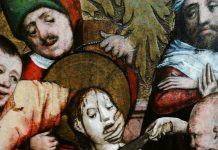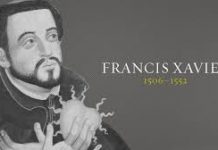The first bishop of Canterbury, Augustine (+604), pronounced in England, ‘Austin’, was a Roman citizen, like the ‘other’ Augustine, of Hippo, who lived over two centuries before, in northern Africa. Neither would have considered himself ‘African’ or ‘Italian’, but Roman, for there was but one civilization. So too, there was one ‘Church’ to which they belonged. Both empire and Church were Roman and Catholic.
As Hilaire Belloc points out, the whole notion of ‘nations’ came much later in history. Outside of the Empire, were the pagan, the un-civilized, the barbarians – the yet-to-be-redeemed. We are a long way yet from Rousseaus fervid dreams of noble savages as the ideal of Man.
Also, there were no ‘denominations’ of Christians, and, as Newman discovered in his own historical research, Anglicanism did not come to be until after Henry VIII, its progenitor; as the Oratorian put it, to delve into history is to cease to be a Protestant.
Augustine, that is, of Canterbury (we now know him by the name of his See), seems to have originally belonged to the Benedictine monastery on the Coelian Hill in Rome, founded by Pope Gregory, later to be called ‘Great’, the same one who in 595 chose his fellow monk Augustine to lead the mission to the pagan ‘Angles’ in the south of Britain, with 40 other monks, .
Contemporary accounts say that Gregory’s missionary zeal was prompted after witnessing some ‘Angles’ being sold as slaves in a market place (who would give their name to ‘England’), Gregory was moved to do something to turn these fair-haired ‘Angles’ into Angels, and not just them, but all the other tribes they would discover, the Saxons, Celts, Picts, all of those ‘outside the frontier’, for by the time of Gregory, the empire was not only civilized, but Catholic.
The Romans had spread abroad, through might and main, the material benefits of their culture, the whole codification of laws, military discipline and training, building techniques, plumbing and clean water, and sewage, literature, two refined and advanced languages (Latin and Greek) allowing for the advancement of thought and philosophy, as well as, while we’re at it, heated flooring and fine red wine.
They made a foothold in Britain, but the legionaries departed in 410, not to return, and the island had sunk to some degree back into barbarism. Irish missionaries had made some advance in evangelizing the north of the island – Scotland and Northumbria, but the south remained largely unconverted.
So Gregory and Augustine wanted to offer the pagans, as they themselves had received, all the supernatural goodness that would perfect what natural foundation they had: the Church’s creed, her moral code, and a structured prayer and liturgical life, not least the Holy Eucharist (which is ultimately why all the cathedrals were built, and which holds everything else together), all of which produced a human flourishing, in this life but, more importantly, in the next.
Again, to Belloc, who declared quite emphatically that is was the Faith that built Europe.
After initially becoming discouraged, but prompted by Pope Gregory to persevere, Augustine and his merry band of stalwart missionaries landing on the isle of Thanet in 597, whence they finally landed in the ancient town of Canterbury.
I was intrigued to learn that what struck the people of Canterbury (about 18 miles from the coast, then called by its original Latin name of Durovernum) was the solemn procession of the monks into the town, these hardy, masculine, celibate men, completely dedicated to God, bearing the Cross and intoning in unison one of the ‘rogation’ litanies, in that beautiful and mystical Gregorian chant, named after the same Pope.
What a sight it must have been, and I don’t think the same impression would have been made by what passes now for liturgical music. Proper devotional chant and polyphony are indeed the greatest artistic treasure of the church, and a most fitting means of evangelization.
King Aethelbert, a pagan, had married, Bertha, the daughter of Chilibert, the King of France, both Catholics. He was soon convinced by the teaching and example of the monks, and accepted baptism. Thousands of his people soon followed, and England, in a word, became Christian in the full ‘Catholic’, or universal, sense of that word.
The king gave them a grant of land outside the town, and the monks, as is their wont, got to building, tilling and cultivating; the impressive monastery ruins that stand to this day are a silent, but powerfully evocative, testament to what they accomplished. It was the monks who constructed, in more ways than physically, what was and is known as ‘Canterbury’.
The imposing cathedral, which dwarfs in size most modern buildings, where Becket would be martyred near a side altar six centuries later, was constructed in the 12th century, itself a witness to the deep faith that had been instilled in the once-pagan ‘Angles’.
Augustine, who had been consecrated a bishop by the Pope, set up his episcopal see at Canterbury, overseeing and building up the church in remarkable manner, until the whole land was Catholic, and Roman, before dying, full of good works, on May 26th, 604. He was immediately hailed as a saint,
And so Canterbury, and all of England remained, Catholic to the core, until the tragic years of 1535-40, when the Faith was all-but-obliterated from Britain; the fates of Buckfast, Walsingham and all the monasteries in the realm also befell the Augustinian Abbey: Gutted and looted, the monks disbanded, and the glorious edifices either handed over to the King’s courtiers and yes-men, or left to rack and ruin. But those very ruins of Canterbury’s monastery still evoke what Augustine and those monks accomplished against insuperable odds, and what they did, we may do again.
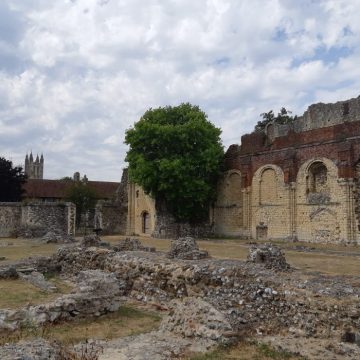
We could use a new band of merrie monks like Augustine, full of hope and joy, who may once again sow the seeds of Faith, which will bear fruit amongst the wreckage, like sparks in stubble.

